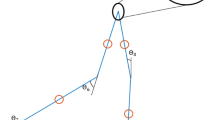Abstract
The simulation of human gait is a complex dynamical problem that requires accounting for energy consumption as well as dealing with a redundantly actuated multibody system. If muscle forces and generalized coordinates are parameterized, optimization techniques allow the simulation of the muscle forces and of the walking motion. An optimization framework is presented for non-symmetrical gait cycles found in the presence of one-sided gait disorders. The motion of each leg is independently parameterized for a whole walking cycle. The non-linear constraints used to fulfill the equations of motion and the kinematical constraints of the different walking phases are implemented in an efficient way. Fifth-order splines are used for the parameterization to reduce the oscillatory behavior coming from non-periodicity conditions. To achieve the computational performance required for three-dimensional simulations, the spline interpolation problem has been split in two parts, one is performed in a preprocessing stage and the other during the optimization. Numerical differentiation via finite differences is avoided by implementing analytical derivatives of the splines functions and of the contractile element force law. The results show good numerical performance, and the computational efficiency for 3D-simulations with one-sided gait disorders is highlighted.
Similar content being viewed by others
References
Ackermann, M.: Dynamics and Energetics of Walking with Prostheses. PhD thesis, Institut für Technische und Numerische Mechanik, Stuttgart (2007)
Ackermann, M., Gros, H.: Measurements of Human Gaits. Technical Report of Zwischenbericht ZB-144, Institute of Engineering and Computational Mechanics, University of Stuttgart, 70550 Stuttgart (2005)
Ackermann M., Schiehlen W.: Dynamic analysis of human gait disorder and metabolical cost estimation. Arch. Appl. Mech. 75(10–12), 569–594 (2006)
Al Nazer R., Rantalainen T., Heinonen A., Sievänen H., Mikkola A.: Flexible multibody simulation approach in the analysis of tibial strain during walking. J. Biomech. 41, 1036–1043 (2008)
Allard, P., Cappozzo, A., Lundberg, A., Vaughan, C.L. (eds.): Three-Dimensional Analysis of Human Locomotion. Wiley, Chichester (1998)
Anderson F., Pandy M.: A dynamic optimization solution for vertical jumping in three dimensions. Comput. Methods Biomech. Biomed. Eng. 2, 201–231 (1999)
Anderson F., Pandy M.: Dynamic optimization of human walking. J. Biomech. Eng. 123, 381–390 (2001)
Bessonnet G., Seguin P., Sardain P.: A parametric optimization approach to walking pattern synthesis. Int. J. Robotics Res. 24(7), 523–536 (2005)
Brand R., Pedersen D., Friederich J.: The sensitivity of muscle force predictions to changes in physiologic cross-sectional area. J. Biomech. 19(8), 589–596 (1986)
Cole G., van den Bogert A., Herzog W., Gerritsen K.: Modeling of force production in skeletal muscle undergoing stretch. J. Biomech. 29, 1091–1104 (1996)
Delp S., Loan J.: A graphics-based software system to develop and analyze models of musculoskeletal structures. Comput. Biol. Med. 25(1), 21–34 (1995)
Kim H., Wang Q., Rahmatalla S., Swan C., Arora J., Abdel-Malek K., Assouline J.: Dynamic motion planning of 3D human locomotion using gradient-based optimization. J. Biomech. Eng. 130, 03100201–03100214 (2008)
Kurz T., Eberhard P., Henninger C., Schiehlen W.: From Neweul to Neweul-M2: symbolical equations of motion for multibody system analysis and synthesis. Multib. Syst. Dyn. 24, 1 (2010)
Menegaldo L., Fleury A., Weber H.: Biomechanical modeling and optimal control of human posture. J. Biomech. 36, 1701–1712 (2003)
Menegaldo L., Fleury A., Weber H.: Moment arms and musculotendon lengths estimtion for a three-dimensional lower-limb model. J. Biomech. 37, 1447–1453 (2004)
Nagano A., Gerritsen K.: Effects of neuromuscular strength training on vertical jumping performance—a computer simulation study. J. Appl. Biomech. 17, 113–128 (2001)
Pandy M.: Computer modeling and simulation of human walking. Annu. Rev. Biomed. Eng. 3, 245–273 (2001)
Peasgood, M., McPhee, J., Kubica, E.: Stabilization and energy optimization of a dynamic walking gait simulation. In: Proceedings of the ASME 2005 International Design Engineering Technical Conferences & Computers and Information in Engineering. Long Beach (Sept 24–28 2005)
Riener R., Edrich T.: Identification of passive elastic joint moments in the lower extremities. J. Biomech. 32, 539–544 (1999)
Rodrgigo S., Ambrosio J., Da Silva M., Penisi O.: Analysys of human gait based on multibody formulations and optimization tools. Mech. Based Des. Struct Mach. 36(4), 446–477 (2008)
Schiehlen W.: Multibody system dynamics: roots and perspectives. Multib. Syst. Dyn. 1, 149–188 (1997)
Stein R., Zehr E., Lebiedowska M., Popovic D., Scheiner A., Chizeck H.: Estimating mechanical parameters of leg segments in individuals with and without physical disabilities. IEEE Trans. Rehabil. Eng. 4(3), 201–211 (1996)
Strang G.: Linear Algebra and Its Applications. 2nd edn. Academic Press, New York (1980)
Umberger B.: Effects of suppressing arm swing on kinematics, kinetics and energetics of human walking. J. Biomech. 41, 2575–2580 (2008)
Umberger B., Gerritsen K., Martin P.: A model of human muscle energy expendidure. Comput. Methods Biomech. Biomed. Eng. 6(2), 99–111 (2003)
van Soest A., Bobbert M.: The contribution of muscle properties in the control of explosive movements. Biol. Cybern. 69, 195–204 (1993)
Winter D.: The Biomechanics and Motor Control of Human Gait: Normal Elderly and Pathological. University of Waterloo Press, Waterloo (1991)
Wojtyra M.: Multibody simulation of human walking. Mech. Based Des. Struct. Mach. 31(3), 357–379 (2003)
Zatsiorsky V.: Kinematics of Human Motion. Human Kinetics, Champaign, Illinois (1998)
Author information
Authors and Affiliations
Corresponding author
Rights and permissions
About this article
Cite this article
García-Vallejo, D., Schiehlen, W. 3D-Simulation of human walking by parameter optimization. Arch Appl Mech 82, 533–556 (2012). https://doi.org/10.1007/s00419-011-0571-7
Received:
Accepted:
Published:
Issue Date:
DOI: https://doi.org/10.1007/s00419-011-0571-7




